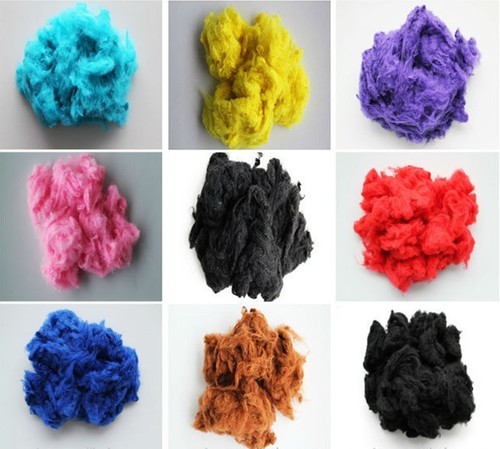Because of its intrinsic flame resistance and adaptable qualities, flame retardant polyester staple fiber (FRPSF) is a high-performance material that is utilized extensively in many different sectors. This fiber, which is used in a variety of products, including industrial textiles, home furnishings, and protective apparel, is very advantageous to the textile sector. This article provides a comprehensive understanding of flame-retardant polyester staple fiber, including its properties, manufacturing processes, benefits, and diverse applications.
What is Flame Retardant Polyester Staple Fiber?
The synthetic fiber known as flame-retardant polyester staple fiber is created from polyester that has undergone chemical modification to prevent ignition and reduce the rate at which flames spread. This fiber is designed to maintain its integrity and prevent the rapid propagation of fire, making it an essential material in environments where fire safety is a critical concern.
Polyester itself is a polymer made from polyethylene terephthalate (PET), which is commonly used in textile production due to its durability, strength, and resistance to environmental factors. However, PET in its natural form is highly flammable. To counteract this, flame retardant chemicals are introduced during the manufacturing process to reduce the fiber’s flammability. These additives can be either incorporated during the fiber production or applied as a coating in a secondary process.
Important Characteristics of Polyester Staple Fiber That Resists Flames
Flame Resistance: FRPSF’s capacity to withstand ignite and extinguish itself when the flame source is eliminated is its most important feature. The fiber can tolerate high temperatures without igniting, depending on the kind of flame retardant utilized.
Durability: Polyester fibers are known for their strength, which is maintained even when the fiber is treated with flame retardants.
Low Shrinkage: Flame retardant polyester staple fiber exhibits low shrinkage when exposed to heat, making it an ideal choice for applications where dimensional stability is required.
Moisture Resistance: While polyester naturally resists moisture absorption, the flame retardant treatment does not negatively affect this property. The fiber remains resistant to mildew, mold, and rot, even in humid conditions.
Lightweight: The fiber is lightweight and soft, making it suitable for use in textiles that require comfort without sacrificing durability or safety features.
Non-Toxicity: Modern flame retardants are increasingly being designed to be non-toxic, ensuring that FRPSF does not pose health risks during its use or when subjected to high temperatures.
Color Retention: Polyester fibers retain their color even after exposure to flame retardants, ensuring that textile products maintain their appearance and aesthetic qualities.

Production Method for Flame-Retardant Polyester Staple Fiber
The manufacturing process of FRPSF generally involves two main approaches: adding flame retardant chemicals during fiber production or applying a flame retardant coating in a secondary stage.
1. Incorporation During Polymerization
The most common method for producing flame retardant polyester staple fiber is through the incorporation of flame retardant additives into the polyester polymer during the polymerization process. The flame retardant is chemically bonded to the polyester chain, ensuring that the flame resistance is permanent and does not wash out over time. This method is particularly useful for producing fibers for applications where long-lasting flame resistance is required.
2. Coating or Finishing Process
Another method is to apply a flame retardant coating to the surface of the polyester staple fiber after it has been spun. The coating inhibits the spread of flames and prevents ignition by forming a protective barrier. While this approach is cost-effective, the flame retardant properties may diminish over time with washing or wear.
3. Blending with Other Fibers
To improve some qualities, like breathability or texture, flame-retardant polyester staple fiber is occasionally combined with other fibers, such as cotton or nylon. These blends offer a combination of flame resistance and the desirable attributes of the other fibers used.
Types of Flame Retardants Used in Polyester Staple Fiber
The types of flame retardants used in FRPSF can vary, and their selection depends on the specific application and desired performance characteristics. Below are the most commonly used types:
- Halogen-Based Flame Retardants: These are effective and widely used flame retardants that release halogens (usually bromine or chlorine) when exposed to heat. They can be highly effective in reducing flammability, but their environmental and health impacts have led to a decline in their use in favor of safer alternatives.
- Phosphorus-Based Flame Retardants: These retardants work by releasing phosphoric acid under heat, which forms a protective char on the fiber, slowing down the spread of flames. Phosphorus-based retardants are less toxic and more environmentally friendly compared to halogen-based alternatives.
- Inorganic Flame Retardants: Non-toxic flame retardants include substances like magnesium hydroxide and aluminum hydroxide. These compounds are effective at high temperatures and have minimal environmental impact.
- Nitrogen-Based Flame Retardants: To improve their effectiveness, they are frequently combined with other flame retardants. They work by releasing nitrogen gas during combustion, which reduces the available oxygen and slows down the flame spread.
Applications of Flame Retardant Polyester Staple Fiber
The flame retardant properties of polyester staple fiber make it an ideal material for use in a wide range of applications. Some of the major sectors and applications for FRPSF are listed below:
1. Protective Apparel
Flame retardant polyester staple fiber is a critical material in the production of protective clothing for industries where workers are exposed to fire or high heat, such as the oil and gas, electrical, and chemical industries. The fibers are woven into fabrics used in flame-resistant suits, jackets, pants, gloves, and helmets, offering protection against flash fires, sparks, and heat. The durable nature of FRPSF ensures that these garments retain their protective qualities over time, even with frequent washing.
2. Home Furnishings
In residential and commercial applications, FRPSF is used in the production of flame-resistant curtains, upholstery fabrics, and bedding. These products help prevent the spread of fire in case of an accident, enhancing safety in homes, offices, hotels, and hospitals. The aesthetic appeal of polyester, combined with its flame resistance, makes it an ideal material for these applications.
3. Automotive Textiles
The automotive industry uses flame-retardant polyester staple fiber in the manufacturing of car upholstery, seat covers, headliners, and carpets. FRPSF provides fire protection while maintaining comfort and durability, helping to meet stringent safety regulations required by automotive standards.
4. Construction and Building Materials
Flame retardant polyester staple fiber is used in building materials such as insulation products and nonwoven fabrics for ceiling tiles and wall coverings. These materials are crucial for enhancing the fire safety of residential and commercial buildings, particularly in high-rise buildings where fire risks can be severe.
5. Industrial and Military Applications
FRPSF is also used in industrial textiles such as fire blankets, safety nets, and conveyor belts in high-risk environments. Military and aerospace applications also utilize flame retardant fibers in protective gear, tents, and other equipment.
6. Consumer Products
In addition to industrial and protective applications, FRPSF is used in consumer products such as mattresses, carpets, and clothing, where fire safety is a priority. Polyester’s inherent durability and ease of maintenance, combined with its flame resistance, make it a practical choice for these products.
Benefits of Flame Retardant Polyester Staple Fiber
- Enhanced Safety: FRPSF significantly reduces the risk of fire-related injuries and property damage, making it essential in fire-sensitive environments.
- Sustainability: As a synthetic material, polyester staple fiber is highly durable, leading to products that last longer and reduce the need for frequent replacements, ultimately contributing to sustainability.
- Cost-Effectiveness: Polyester is an affordable and versatile material, making flame-retardant polyester staple fiber a cost-effective solution for various industries without compromising on safety.
- Versatility: The fiber can be used in a variety of forms, including woven, knitted, or nonwoven fabrics, offering adaptability across many applications.
Conclusion
In many different sectors, flame-retardant polyester staple fiber is essential for improving fire safety. Its inherent flame resistance, durability, and versatility make it a preferred choice for protective clothing, home furnishings, automotive textiles, and building materials. The ability to integrate flame retardants in a way that maintains the fiber’s strength, appearance, and comfort makes it a valuable material in industries that prioritize safety and performance. As technology advances, the development of environmentally friendly flame retardants ensures that FRPSF will continue to serve a wide range of industries in the future.

